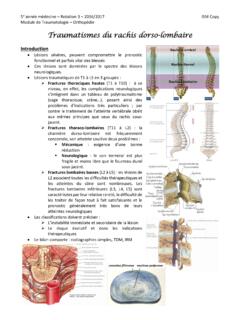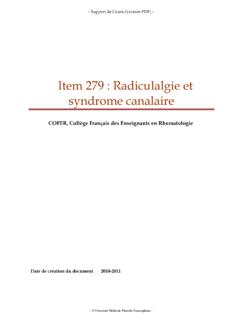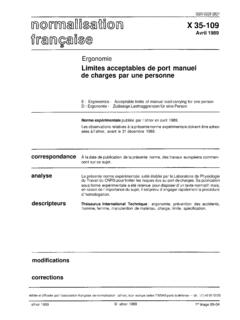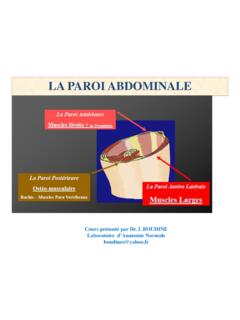Transcription of Musculoskeletal Disorders and Workplace Factors
1 Musculoskeletal Disorders andWorkplace FactorsA Critical Review of Epidemiologic Evidence forWork-Related Musculoskeletal Disorders of the Neck,Upper Extremity, and Low Back Edited by:Bruce P. Bernard, , :Vern Putz-Anderson, P. Bernard, , E. BurtLibby L. Cole, Fairfield-EstillLawrence J. Fine, , A. Grant, GjessingLynn JenkinsJoseph J. Hurrell Jr., Nelson, PfirmanRobert RobertsDiana Stetson, Haring-Sweeney, Tanaka, DEPARTMENT OF HEALTH AND HUMAN SERVICESP ublic Health ServiceCenters for Disease Control and PreventionNational Institute for Occupational Safety and HealthJuly 1997iiThis document is in the public domain and may be freely copied or of any company name or product does not constitute endorsement by theNational Institute for Occupational Safety and Health. Copies of this and other NIOSH documents are available fromNational Institute for Occupational Safety and HealthPublications Dissemination4676 Columbia ParkwayCincinnati, OH 45226 1998 Telephone number: 1 800 35 NIOSH (1 800 356 4674)Fax number: (513) 533 8573E-mail: receive other information about occupational safety and health problems, call 1 800 35 NIOSH(1 800 356 4674), or visit the NIOSH Home Page on the World Wide Web at publication is also available from theNational Technical Information Service for $ plus $ call (703) 487 4650 and ask for PB97 (NIOSH) Publication No.
2 97BB141iiiFOREWORDM usculoskeletal Disorders (MSDs) were recognized as having occupational etiologic Factors as early asthe beginning of the 18th century. However, it was not until the 1970s that occupational Factors wereexamined using epidemiologic methods, and the work-relatedness of these conditions began appearingregularly in the international scientific literature. Since then the literature has increased dramatically;more than six thousand scientific articles addressing ergonomics in the Workplace have been , the relationship between MSDs and work-related Factors remains the subject of considerabledebate. Musculoskeletal Disorders and Workplace Factors : A Critical Review of Epidemiologic Evidencefor Work-Related Musculoskeletal Disorders of the Neck, Upper Extremity, and Low Back willprovide answers to many of the questions that have arisen on this topic over the last decade. Thisdocument is the most comprehensive compilation to date of the epidemiologic research on the relationbetween selected MSDs and exposure to physical Factors at work.
3 On the basis of our review of theliterature, NIOSH concludes that a large body of credible epidemiologic research exists that shows aconsistent relationship between MSDs and certain physical Factors , especially at higher exposure document, combined with other NIOSH efforts in this area, will assist us in our continued efforts toaddress these inherently preventable Rosenstock, , , National Institute for Occupational Safety and HealthCenters for Disease Control and PreventionivvNOTE TO THE READERThis second printing of Musculoskeletal Disorders and Workplace Factors : A Critical Review ofEpidemiologic Evidence for Work-Related Musculoskeletal Disorders of the Neck, UpperExtremity, and Low Back incorporates a number of editorial changes, including grammar, formatting,and consistency issues that were identified in the first printing. In addition, the notation of Dr. LawrenceFine as co-editor was inadvertently omitted in the first printing and has been conclusions of the document in terms of decisions regarding the weight of the existing epidemiologicevidence for the relationship between Workplace Factors and Musculoskeletal Disorders remainunchanged.
4 The following technical inconsistencies or errors were corrected:Page 2-14: Text was corrected to reflect that five studies (as opposed to three) examined therelationship between force and Musculoskeletal Disorders of the 2-28: For Viikari-Juntura [1994], the NR entry in the Risk Indicator column was replaced withthe value 2-34: Bergqvist [1995a] was changed to Bergqvist [1994]. The Risk Indicator entry for thisstudy was changed from to (both noted as statistically significant), the entry for PhysicalExamination was changed from Yes to No, and the entry for Basis for Assessing Exposure waschanged from job titles or self-reports to observation or measurements. Page 3-3: Text was corrected to reflect that four studies (as opposed to three) met all four evaluationcriteria. A description of Kilbom and Persson [1987] was moved forward in the chapter to this sectionand includes a clarification that health outcome in their study was based on symptoms and 3-32: The confidence interval depicted for Ohlsson [1994] was corrected to show a range to 3-69: Schibye et al.
5 [1995] was added to Table 3-5. Page 4-25: Dimberg [1989] was changed to Dimberg [1987]. viPage 5a-3: Text was corrected to reflect that nineteen studies (as opposed to fifteen) reported resultson the association between repetition and carpal tunnel syndrome (CTS). Text was also corrected toreflect that five studies (as opposed to four) met the four evaluation criteria for addressing repetitivenessand CTS. A description of Osorio et al. [1994] was moved forward in the chapter to this 5a-15: Text was corrected to reflect that eleven studies (as opposed to ten) reported results onthe association between force and CTS and that four (as opposed to three) met all four evaluationcriteria. Descriptions of Moore and Garg [1994] and Osorio et al. [1994] were moved forward in thechapter to this 5a-19 : The discussion (strength of association, temporality, consistency of association, coherenceof evidence, and exposure-response relationship) of force and CTS was inadvertently omitted in thefirst printing and has been 5a-27: The Risk Indicator for Osorio et al.
6 [1994] was changed from to , and for Nathan[1992], the No association entry under Risk Indicator was changed to a value of Page 5a-29: Stetson et al. [1993] was moved to the bottom of the table, and entries for Nathan et al. [1992] and McCormack et al. [1990] were 5a-31: This table was modified to more accurately reflect the 5a-33: For Koskimies et al. [1990], the entry for Basis for Assessing Exposure was changedfrom observation or measurements to job titles or self-reports. Page 5b-1: Text was corrected to reflect that seven studies (as opposed to eight) are referenced onTable 5c-4: Text was corrected to reflect that five studies (as opposed to four) met three of the criteria. A brief description of Kivek s et al. [1994] was added to this number of references were clarified, and full references for studies that were cited in the text of thefirst printing but were inadvertently omitted from the reference list were added.
7 Appendix C was added to the document to provide a concise overview of the studies reviewed relativeto the evaluation criteria, risk Factors addressed, and other to the 1. and Magnitude of the Health of for Analyzing or Synthesizing for Used to Classify the Evidence of of Tables, Figures, and 2. Neck Musculoskeletal Disorders : Evidence or Neck/Shoulder MSDs and the Role of and 3. Shoulder Musculoskeletal Disorders : Evidence .. of and 4. Elbow Musculoskeletal Disorders (Epicondylitis):Evidence for ..4-16 Epicondylitis and the Role of and 5. Hand/Wrist Musculoskeletal Disorders (Carpal TunnelSyndrome, Hand/Wrist Tendinitis, and Hand-ArmVibration Syndrome): Evidence for 5a. Carpal Tunnel and Exposure and and and and and 5b. Hand/Wrist and 5c. Hand-Arm Vibration for the Work-Relatedness of and 6. Low-Back Musculoskeletal Disorders : Evidence Physical and Forceful and Twisting (Awkward Postures).
8 6-21 Whole Body Vibration (WBV)..6-26 Static Work of and 7. Work-Related Musculoskeletal Disorders andPsychosocial .. Disorders (Neck, Shoulder, Elbow, Hand, and Wrist)..7-3 Back and Figures ..A-1A. Epidemiologic Individual Factors Associated with Work-Related Musculoskeletal Disorders (MSDs).. SUMMARYThe term Musculoskeletal Disorders (MSDs) refers to conditions that involve the nerves, tendons,muscles, and supporting structures of the body. The purpose of this NIOSH document is to examinethe epidemiologic evidence of the relationship between selected MSDs of the upper extremity and thelow back and exposure to physical Factors at work. Specific attention is given to analyzing the weight ofthe evidence for the strength of the association between these Disorders and work Factors . Because the relationship between exposure to physical work Factors and the development andprognosis of a particular disorder may be modified by psychosocial Factors , the literature aboutpsychosocial Factors and the presence of Musculoskeletal symptoms or Disorders is also these associations and relating them to the cause of disease is critical for identifyingexposures amenable to preventive and therapeutic interventions.
9 MAGNITUDE OF THE PROBLEMThe only routinely collected national source of information about occupational injuries and illnesses workers is the Annual Survey of Occupational Injuries and Illnesses conducted by the Bureau ofLabor Statistics (BLS) of the Department of Labor. The survey, which BLS has conducted for thepast 25 years, is a random sample of about 250,000 private sector establishments and providesestimates of Workplace injuries and illnesses on the basis of information provided by employers fromtheir OSHA Form 200 log of recordable injuries and illnesses. For cases involving days away from work, BLS reports that in 1994 (the last year of data available atthe time this report was prepared), approximately 705,800 cases (32%) were the result of overexertionor repetitive motion. Specifically, there were C367,424 injuries due to overexertion in lifting (65% affected the back); 93,325 injuries due tooverexertion in pushing or pulling objects (52% affected the back); 68,992 injuries due tooverexertion in holding, carrying, or turning objects (58% affected the back).
10 Totaled acrossthese three categories, 47,861 Disorders affected the shoulder. C83,483 injuries or illnesses in other and unspecified overexertion C92,576 injuries or illnesses due to repetitive motion, including typing or key entry, repetitive use oftools, and repetitive placing, grasping, or moving of objects other than tools. Of these injuries orillnesses, 55% affected the wrist, 7% affected the shoulder, and 6% affected the back. Data for 1992 to 1995 indicate that injuries and illnesses requiring days away from work declined 19%for overexertion and 14% for repetitive motion. The incidence rate of overexertion (in lifting) declinedfrom per 10,000 workers in 1992 to in 1995; the incidence rate for repetitive motiondisorders declined from per 10,000 workers in 1992 to in 1995. These declines are similarto those seen for cases involving days away from work from all causes of injury and reasons for these declines are unclear but may include: a smaller number of Disorders could beoccurring because of more intensive efforts to prevent them; more effective prevention and treatmentprograms could be reducing days away from work; employers or employees may be more reluctant toreport or record Disorders ; or the criteria used by health care providers to diagnose these conditionscould be AND SELECTION OF STUDIESThe goal of epidemiologic studies is to identify Factors that are associated (positively or negatively) withthe development or recurrence of adverse medical conditions.














